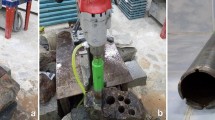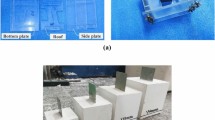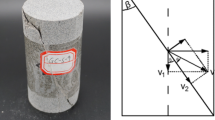Abstract
Numerous experimental results show the compressive strength of rock decreases with the increase of rock size. Researchers have developed different empirical failure criteria to correlate the decreasing size effect of compressive strength. For the first time, this research theoretically derived the size-dependent Mohr–Coulomb failure criterion based on the Griffith theory. The failure criterion contains three parameters: the cohesion, the friction angle, and the scaling exponent, which can be determined based on the uniaxial compression test of different-sized specimens and the triaxial compression test of standard-sized specimens. The determined failure criterion can be used to predict the compressive strength of different-sized rocks at different compressive stress conditions. This failure criterion demonstrates that the cracks inside rock cause the size effect, and the crack length distribution affects the size effect. Next, this research developed the bonded-particle model of rock to verify the failure criterion. The rock model consists of matrix and cracks that are modeled by bonded particles and discrete fractures, respectively. The modeling result shows that the strength of matrix model is size independent, and the introduction of cracks causes the size effect of rock model. The parametric analysis verified the influence of crack length distribution on the size effect according to the failure criterion. At last, this research summarized the experimental data of uniaxial and triaxial compressive strength in previous size effect research to check the applicability of the failure criterion. The fitting result shows the failure criterion fits well with the experimental data. Moreover, this research found experimental evidence to support the failure criterion.



















Similar content being viewed by others
Data Availability
The data that support the findings of this study are available in Zhao (2022).
References
Abou-Sayed AS, Brechtel CE (1976) Experimental investigation of the effects of size on the uniaxial compressive strength of cedar city quartz diorite. In: The 17th US Symposium on Rock Mechanics (USRMS)
Baecher GB, Einstein HH (1981) Size effect in rock testing. Geophys Res Lett 8:671–674
Bažant ZP (1984) Size effect in blunt fracture: concrete, rock, metal. J Eng Mech 110:518–535
Bieniawski ZT (1968) Propagation of brittle fracture in rock. In: The 10th US Symposium on Rock Mechanics (USRMS)
Bonnet E, Bour O, Odling NE, Davy P, Main I, Cowie P, Berkowitz B (2001) Scaling of fracture systems in geological media. Rev Geophys 39:347–383
Carpinteri A (1994) Fractal nature of material microstructure and size effects on apparent mechanical properties. Mech Mater 18:89–101
Carpinteri A, Chiaia B, Ferro G (1995) Size effects on nominal tensile strength of concrete structures: multifractality of material ligaments and dimensional transition from order to disorder. Mater Struct 28:311
Darlington WJ, Ranjith PG, Choi SK (2011) The effect of specimen size on strength and other properties in laboratory testing of rock and rock-like cementitious brittle materials. Rock Mech Rock Eng 44:513–529
Gonzatti C, Zorzi L, Agostini IM, Fiorentini JA, Viero AP, Philipp RP (2014) In situ strength of coal bed based on the size effect study on the uniaxial compressive strength. Int J Min Sci Technol 24:747–754
Griffith A (1924) The theory of rupture. First Int Cong Appl Mech, a221
Hawkins AB (1998) Aspects of rock strength. Bull Eng Geol Environ 57:17–30
Herget G, Unrug K (1976) In situ rock strength from triaxial testing. Int J Rock Mech Min Sci Geomech Abstr 13(11):299–302
Hoek E, Brown ET (1980) Underground excavations in rock, 1st ed.CRC Press, pp 155–156
Hoskins JR, Horino FG (1969) Influence of spherical head size and specimen diameters on the uniaxial compressive strength of rocks. [16 refs]. United States
Itasca Consulting Group (2019) PFC 6.0 documentation
Jackson R, Lau J (1990) The effect of specimen size on the laboratory mechanical properties of Lac du Bonnet grey granite. Proceedings of the first International Workshop on Scale Effects in Rock Masses, pp 165–174
Jahns H (1966) Measuring the strength of rock in situ at an increasing scale. Paper presented at the 1st ISRM Congress, Lisbon, Portugal
Kong X, Liu Q, Lu H (2021) Effects of rock specimen size on mechanical properties in laboratory testing. J Geotech Geoenviron Eng 147:04021013
Li K (2019) Size effect and anisotropy in transversely isotropic rocks. Doctor’s thesis. Hong Kong Polytechnic University
Li K, Yin Z-Y, Han D, Fan X, Cao R, Lin H (2021) Size effect and anisotropy in a transversely isotropic rock under compressive conditions. Rock Mech Rock Eng 54(9):4639–4662
Lundborg N (1967) The strength-size relation of granite. Int J Rock Mech Min Sci Geomech Abstr 4(3):269–272
Masoumi H, Roshan H, Hagan PC (2017) Size-dependent Hoek-Brown failure criterion. Int J Geomech 17(2):04016048
Masoumi H, Saydam S, Hagan PC (2016) Unified size-effect law for intact rock. Int J Geomech 16:1–15
McClintock FA, Walsh J (1962) Friction on Griffith’s cracks in rock under pressure. US National Congress on Applied Mechanics, pp 1015–1021
Medhurst TP, Brown ET (1998) A study of the mechanical behaviour of coal for pillar design. Int J Rock Mech Min Sci 35:1087–1105
Mogi K (1962) The influence of the dimensions of specimens on the fracture strength of rocks: comparison between the strength of rock specimens and that of the earth’s crust. Bull. Earthq. Res. Institute. Univ Tokyo 40:175–185
Natau OP, Frohlich BO, Mutschler TO (1983) Recent developments of the large·scale triaxial test. In: 5th ISRM Congress, pp 65–74
Nishimatsu Y, Yamaguchi U, Motosugi K, Morita M (1969) The size effect and experimental error of the strength of rocks. J Min Mat Proc Inst Jpn 18:1019–1025
Orowan E (1949) Fracture and strength of solids. Rep Prog Phys 12:185
Panek LA, Fannon TA (1992) Size and shape effects in point load tests of irregular rock fragments. Rock Mech Rock Eng 25:109–140
Peng SS (2015) Topical areas of research needs in ground control–a state of the art review on coal mine ground control. Int J Min Sci Technol 25:1–6
Pierce M, Gaida M, DeGagne D (2009) Estimation of rock block strength. In: RockEng09 (Proceedings, 3rd CANUS Rock Mechanics Symposium, Toronto
Potyondy DO (2019) Material-modeling support in PFC [fistpkg6.6]. Itasca Consult. Group, Inc., Minneapolis, Minnesota, Tech. Memo. ICG7766-L (December 11, 2019)
Potyondy DO, Cundall PA (2004) A bonded-particle model for rock. Int J Rock Mech Min Sci 41:1329–1364
Pratt HR, Black AD, Brown WS, Brace WF (1972) The effect of speciment size on the mechanical properties of unjointed diorite. Int J Rock Mech Min Sci Geomech Abstr 9(4):513–516
Quiñones J, Arzúa J, Alejano LR, García-Bastante F, Mas Ivars D, Walton G (2017) Analysis of size effects on the geomechanical parameters of intact granite samples under unconfined conditions. Acta Geotech 12:1229–1242
Shi Q, Mishra B, Zhao Y (2022) DEM analysis of the effect of lamination properties on the stability of an underground coal mine entry with laminated shale roof. Min Metall Explor 39(2):495–506
Simon R, Deng D (2009) Estimation of scale effects of intact rock using dilatometer tests results. In: 62nd Canadian Geotechnical Conference, Halifax. p 481–488
Singh MM, Huck PJ (1972) Large scale triaxial tests on rock. In: The 14th US Symposium on Rock Mechanics (USRMS)
Song H, Jiang Y, Elsworth D, Zhao Y, Wang J, Liu B (2018) Scale effects and strength anisotropy in coal. Int J Coal Geol 195:37–46
Tani K (2001) Scale effect on shear strength of sedimentary soft rocks observed in triaxial compression test (influence of potential joints). In: 36th National Conference of the Japanese Geotechnical Society. p 597–598
Weibull W (1939) A statistical theory of the strength of materials. Stockholm: Generalstabens litografiska anstalts förlag
Yoshinaka R, Osada M, Park H, Sasaki T, Sasaki K (2008) Practical determination of mechanical design parameters of intact rock considering scale effect. Eng Geol 96:173–186
Zhai H, Masoumi H, Zoorabadi M, Canbulat I (2020) Size-dependent behaviour of weak intact rocks. Rock Mech Rock Eng 53:3563–3587
Zhao Y (2022) Size effect and anisotropy on the strength of shale under compressive stress conditions. Doctor’s thesis. West Virginia University
Author information
Authors and Affiliations
Corresponding author
Ethics declarations
Competing interests
The authors declare no competing interests.
Rights and permissions
Springer Nature or its licensor (e.g. a society or other partner) holds exclusive rights to this article under a publishing agreement with the author(s) or other rightsholder(s); author self-archiving of the accepted manuscript version of this article is solely governed by the terms of such publishing agreement and applicable law.
About this article
Cite this article
Zhao, Y., Mishra, B., Shi, Q. et al. Size-dependent Mohr–Coulomb failure criterion. Bull Eng Geol Environ 82, 218 (2023). https://doi.org/10.1007/s10064-023-03243-y
Received:
Accepted:
Published:
DOI: https://doi.org/10.1007/s10064-023-03243-y




